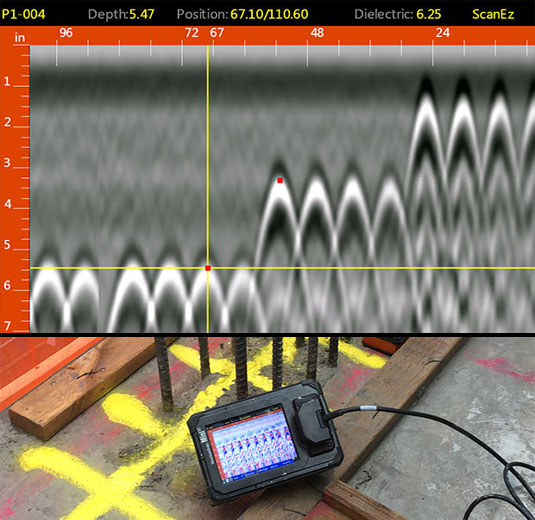Nationwide RainierGPR Service Areas for Advanced Concrete Scanning
Nationwide RainierGPR Service Areas for Advanced Concrete Scanning
Blog Article
Concrete Scanning: An Essential Step Towards Making Sure Architectural Integrity and Safety And Security
In the realm of building and infrastructure maintenance, the relevance of concrete scanning can not be overemphasized. By using sophisticated technology and techniques, concrete scanning offers as a critical device in guaranteeing that the stability and safety of structures and bridges are upheld to the highest possible standards.
Importance of Concrete Scanning
Concrete scanning plays a critical role in ensuring the architectural honesty and security of buildings and facilities jobs. By making use of sophisticated modern technologies such as ground-penetrating radar (GPR) and electro-magnetic induction, experts can non-destructively inspect concrete structures to identify possible defects, voids, ingrained things, and support layout. This procedure makes it possible for very early detection of anomalies that might jeopardize the stability of a framework, stopping costly damages and making sure the safety and security of residents.
Prior to drilling, cutting, or coring into concrete, scanning assists identify the precise places of rebar, post-tension wires, and various other embedded aspects, lowering the risk of unintentional hits that might lead to structural weak points. Furthermore, concrete scanning help in quality control by validating the density of concrete covers and spotting any kind of discrepancies that might influence the total sturdiness of the framework.
Technology for Concrete Examination

Advantages of Very Early Detection
Timely discovery of structural problems can considerably minimize risks and guarantee the longevity of building jobs. By identifying possible issues at an early stage in the building process, stakeholders can take proactive measures to attend to issues before they intensify right into larger and a lot more pricey troubles. One of the crucial advantages of early detection is the prevention of architectural failings, which can posture significant safety hazards and bring about project hold-ups and monetary losses.
Additionally, early detection permits prompt repairs and maintenance, which can assist prolong the lifespan of the structure. By resolving concerns quickly, construction groups can avoid expensive repair work or also the need for early replacement of architectural components. This aggressive approach not only conserves time and money however also boosts the general security and toughness of the construction job.
Furthermore, very early detection can enhance task preparation and decision-making by supplying stakeholders with valuable insights right into the problem of the framework. Armed with this details, job supervisors can make informed selections regarding building approaches, products, and timelines, leading to much more efficient and effective job results.
Guaranteeing Architectural Stability
Ensuring the structural stability of a building and construction task is critical to its safety and longevity. Concrete scanning plays a crucial role in guaranteeing structural security by detecting possible concerns such as voids, delamination, or read the full info here reinforcement rust that can compromise the stability of the structure over time.
By using sophisticated scanning modern technologies like ground-penetrating radar (GPR) and electro-magnetic induction, building and construction experts can non-invasively inspect concrete frameworks to recognize locations of concern below the surface area. This positive method enables for the early detection of problems or weaknesses, enabling punctual repair work or reinforcement to stop structural failures.
Routine concrete scanning throughout different construction phases and throughout the life cycle of a framework can help preserve its stability, reduce threats, and make sure the security of passengers. By focusing on architectural stability through concrete scanning, construction jobs can enhance their strength and toughness, eventually contributing to greater security and durability.

Protecting Against Crucial Failures
Implementing regular evaluations, such as concrete scanning, can reveal covert defects like spaces, splits, or corrosion that might jeopardize the integrity of a framework. By using innovative scanning technologies like Ground Penetrating Radar (GPR) or Concrete X-ray, engineers can non-destructively examine the problem of concrete and determine weak factors that need support or repair service.

Final Thought
Finally, concrete scanning plays a vital role in ensuring architectural stability and security by using sophisticated technology for early discovery of possible issues. This proactive method aids avoid critical failings and makes certain the security of structures. It is necessary to focus on concrete inspection as a conventional method to safeguard the durability and safety of structures and facilities.
Concrete scanning plays a crucial function in making certain the structural honesty and security of structures and infrastructure jobs. Furthermore, concrete Get More Info scanning aids in top quality control by validating the density of concrete covers and detecting any inconsistencies that might impact the general toughness of the framework. Concrete scanning plays a critical function in ensuring structural security by detecting possible concerns such as spaces, delamination, or reinforcement rust that might compromise the honesty of the structure over time.

In verdict, concrete scanning plays a crucial duty in making read review sure architectural honesty and security by making use of advanced technology for early discovery of possible problems.
Report this page